Hospitals Need Better Surgical Workflows
In today's rapidly shifting healthcare environment, hospitals need to embrace new, optimized scheduling workflows that help surgeons use their block time more efficiently and uncover hidden opportunities not visible to their schedulers. Based on real-time access to the hospital’s surgical scheduling system, these improved workflows carry huge benefits for hospitals, surgeons, nurses, schedulers, and patients.
Improved scheduling workflows enable surgeons to perform more cases even when they have no block time available. By adopting solutions that provide real-time access to the hospital’s surgical scheduling system, surgeons can capitalize on hidden opportunities and maximize their productivity. By efficiently managing their time and resources, surgeons expand their business and generate more revenue for their practice and the hospital.
From a day-to-day perspective, clinic and hospital schedulers benefit most from improved scheduling workflows. Most surgeon practices lack visibility of the hospital’s central scheduling system, especially OR time that has been released by another surgeon. When requesting time for their surgeons, clinic and hospital schedulers make multiple phone calls, trade faxes, and otherwise do an elaborate “dance” to find time on the surgical calendar. With improved scheduling workflows, clinic schedulers can see available slots in real-time, and shorten the time-consuming negotiations with the hospital scheduler. And it works both ways; hospital schedulers no longer have to field call after call inquiring about time the clinic scheduler has no way of knowing is available. It’s a win-win for everyone.
Another significant advantage of adopting streamlined scheduling workflows is that patients receive care more promptly, without having to wait for block time to become available. In the past, patients often faced delays in their treatment plans because of the limited availability of surgical slots. However, by integrating innovative scheduling workflows, hospitals leverage hidden opportunities and optimize surgical schedules. Patients receive the care they need in a timelier manner, reducing wait times and potentially improving their overall prognosis.
Implementing streamlined scheduling workflows benefits surgeons and patients, but also has a positive impact on the lives of nurses and staff. With a more efficient and optimized system in place, nurses develop a more consistent daily schedule. This consistency allows them to plan their personal and professional lives more effectively, ensuring a better work-life balance. By reducing the uncertainty and unpredictability around the surgical schedule, nurse satisfaction remains high. A more stable and motivated nursing workforce positively impacts patient care and outcomes.
Adopting innovative scheduling workflows uncovers new opportunities for surgeons to perform more cases outside of their assigned block. Patients benefit from receiving timely care without unnecessary waiting. Nurses enjoy the advantages of a consistent daily schedule. Schedulers both at the hospital and in the surgeon's office enjoy better, more efficient communication. Finally, hospitals benefit from additional revenue and increased capability to accommodate rising case volumes.

